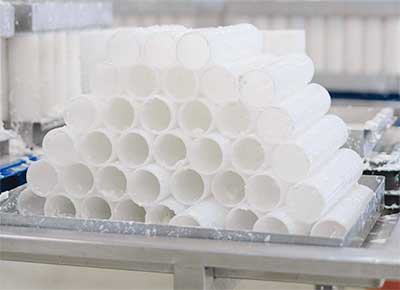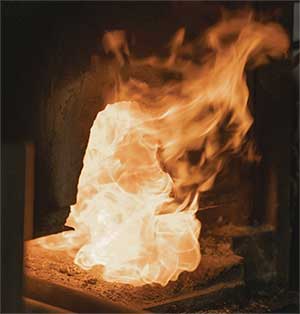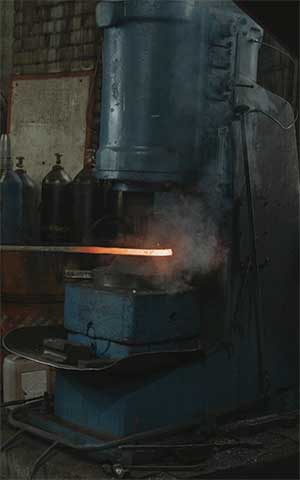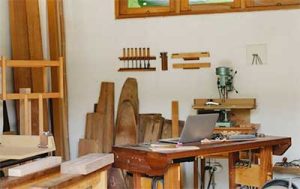Some main types of manufacturing processes, depending on the material to be used, are casting, molding, machining, joining and forming.
Plastic
Plastics come in thousands of varieties with different base chemistries, derivatives and additives. Two main types of plastic are thermoplastics and thermosets.
Some typical thermoplastics are:
- Acrylic (PMMA)
- Acrylonitrile butadiene styrene (ABS)
- Polyamide (PA)
- Polylactic acid (PLA)
- Polycarbonate (PC)
- Polyether ether ketone (PEEK)
- Polyethylene (PE)
- Polypropylene (PP)
- Polyvinyl chloride (PVC)

Plastic extrusion
Plastic extrusion is the heating of the plastic pellets which is then pushed through a heated chamber. This is a manufacturing process in which raw plastic is melted and formed into a profile. Plastic extrusion is a manufacturing process that turns small plastic pellets into solid plastics of different shapes and sizes. Examples of products that can be made with this method include pipes, tubing and window frames.
Plastic Molding
Molding is when the plastic is forced or injected into the mold to give it a final shape of the part. The part cools in the mold until it is solid enough to be ejected. Plastic spatulas, spoons, bowls, plates, cups and eating utensils are generally injection moulded to create precise and durable kitchen equipment.
Other methods for manufacturing plastic include: injection moulding, rotational moulding, plastic extrusion, vacuum casting, thermoforming, 3D printing and Compression moulding.

Metal Fabrication Processes
Forging
Forging is the process involves using forced compression, often done with power-driven presses or hammers, to achieve the desired shape. Done by hand, forging involves heating metal to the point that it can be bent, shaped, and formed with the use of a hammer or other tools. Some of the tools used in the process are: anvil, tong, hammer, flatter, swage, clamping vice and forging dies.

Casting
Casting is the process of pouring molten metal into a mold. From there, the metal and mold is then cooled to the point that it becomes hard. The object is then removed and finished. This process is used in manufacturing and in fine art. Some traditional metal casting techniques include lost-wax casting, plaster mold casting, die casting, and sand casting.
Metal casting is a 7,000-year-old process used for creating sculptures, jewelry, wheels, weapons, and tools. Casting is widely accepted also for mass-produced products where the same mold can be used over and over again. A majority of casting worldwide has been for transportation and heavy equipment. It is a very versatile process and components of metal casting can be found in farming equipment, construction equipment, household appliances, tools, automobile, aerospace, machining tools and much more.

Forming
Forming is the process of bending metal to the desired angle and the process of fashioning metal parts and objects through mechanical deformation. The object is reshaped without adding or removing material. Some forming processes include extrusion, rolling, electromagnetic forming, sheet metal working and forging. Examples for products produced by bulk forming are: gears, valves, engine parts, hydraulic valves, etc.
Other forms of folding can be done with the use of a hammer with clamp bars that hold the metal in place.
Qingdao, China & Casting and Forging
Qingdao is a city of 10 million, and is an excellent launching point for sourcing product from factories in the surrounding regions. Global Trade Specialists has sourced machined parts, castings and forgings, plastic products, clothing and textile items, farming products, and more through our Qingdao partner in this city. It has established itself as a leading manufacturing hub of industry for the region.
Machining, Turning, & Milling
Machining is a process of cutting, shaping, or removing unwanted material to create a form using a machine tool.
Turning uses a lathe to rotate metal at a high speed. This process allows cutting tools to remove the metal in a circular fashion. A CNC machine is the most common tool used for turning.
Milling is very common among the metal fabrication processes. This process involves multi-point cutting tools that remove metal from the workpiece. CNC machines are also used for this process. Often the CNC machines functions as a final finish process creating a desired texture or appearance.
Ningbo, China & Machine Shops
Ningbo is about 130 miles from Shanghai, and has a population of around over 9 million. In 2020, it ranked 8th for the wealthiest cities in China with a powerhouse economy. There are many tool, die and mold shops located in Ningbo, along with machine shops and manufacturing companies of other types of products. Ningbo is a coastal city which makes it a prime area for manufacturing and sourcing, and shipping. The Ningbo-Zhoushan port has been the world’s third largest port. Global Trade Specialists has sourced a lot of metal parts from Ningbo.
Extrusion
Aluminum is one of the most common materials used in extrusion. This process involves forcing either hot or cold metal through a die. Here, the piece of metal is reduced to the cross-section of the die. The end result is usually a long cylindrical shape that’s common in piping or wiring. Metal extrusion is widely used today due to the fast and high production rate and low costs.
Cutting, Punching & Stamping
Cutting is a versatile metal fabrication processes. The process is nothing more than cutting large pieces of metal or removing unwanted material in the form of chips, from a block of metal, using cutting tools. Cutting is quite intricate and involved. Technology like lasers, water jets, and power scissors may be utilized for the cuts.
Punching creates holes in a metal piece or object. This is a precision tool that cuts sheet metal and forms desired shapes and profiles. Punch presses are specially designed to hit the metal through a die to produce holes in specific locations.
Stamping involves creating indentations in metal, instead of holes with the use of a press or handheld hammer. Common applications for stamping are creating shapes, letters, and images.
Welding
Metal welding is the fabrication process of adjoining two or more pieces of metal by heating the parts together and allowing them to cool causing fusion. This is a popular process because various pieces of metal can be conjoined.
Wood Production
 The production processes includes sawing, planing, shaping, laminating, and assembling. Logs are cut into bolts, or lumber that may then be cut further, or shaped by lathes or other tools. Woodworkers tools include circular saws, power jointer and thickness planer, router, handsaw, jigsaw, chisel and others.
The production processes includes sawing, planing, shaping, laminating, and assembling. Logs are cut into bolts, or lumber that may then be cut further, or shaped by lathes or other tools. Woodworkers tools include circular saws, power jointer and thickness planer, router, handsaw, jigsaw, chisel and others.
Global Trade Specialists has access to manufacturers in China making many wood products using all types of material, including maple, rosewood, oak, walnut and more.
Wood products of all types are available to be sourced from China, including pens, boxes, displays, cabinets, furniture, office products, clocks and more. Some of our manufacturers are even equipped with CNC routing machines. Custom laser engraving is also available for all wood products. Pictures, names or logos can be lasered to the size and location you specify.
